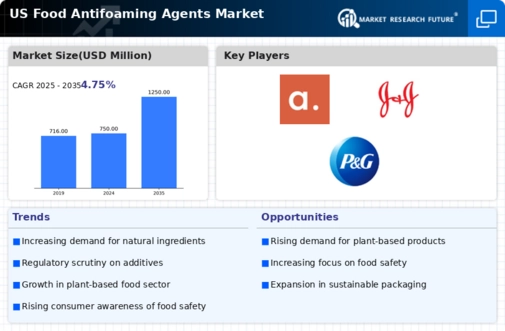Rising Demand for Processed Foods
The food antifoaming-agents market experiences a notable boost due to the increasing demand for processed foods in the US. As consumers seek convenience, the processed food sector is projected to grow at a CAGR of approximately 4.5% over the next few years. This growth necessitates the use of antifoaming agents to enhance product quality and shelf life. The food antifoaming-agents market is thus positioned to benefit from this trend, as manufacturers incorporate these agents to prevent foam formation during production processes, ensuring consistency and stability in food products. Furthermore, the rise in ready-to-eat meals and packaged foods amplifies the need for effective antifoaming solutions, which are essential in maintaining the desired texture and appearance of food items.
Expansion of Dairy and Bakery Sectors
The expansion of the dairy and bakery sectors significantly influences the food antifoaming-agents market. With the US dairy industry valued at over $40 billion, the need for antifoaming agents in processes such as cheese production and milk processing is critical. Similarly, the bakery sector, which has seen a growth rate of around 3% annually, relies on these agents to improve the quality of baked goods. The food antifoaming-agents market is likely to thrive as manufacturers seek to enhance product quality and reduce production inefficiencies. The incorporation of antifoaming agents helps in achieving optimal texture and volume in dairy and bakery products, thereby meeting consumer expectations and regulatory standards.
Increased Focus on Food Quality and Safety
The food antifoaming-agents market is driven by an increased focus on food quality and safety among consumers and manufacturers alike. As food safety regulations become more stringent, the demand for high-quality ingredients, including antifoaming agents, rises. The food antifoaming-agents market is adapting to these changes by ensuring that products meet safety standards while maintaining effectiveness. This trend is particularly evident in sectors such as beverages and sauces, where foam control is crucial for product appeal. The market is projected to grow as companies invest in research and development to create safer, more effective antifoaming solutions that align with consumer preferences for clean-label products.
Consumer Preference for Clean Label Products
The growing consumer preference for clean label products significantly impacts the food antifoaming-agents market. As consumers become more health-conscious, they increasingly seek transparency in food ingredients. This trend prompts manufacturers to reformulate products, often opting for natural or organic antifoaming agents. The food antifoaming-agents market is responding to this shift by developing products that align with clean label demands, potentially leading to a market expansion. The emphasis on clean labels not only enhances consumer trust but also encourages innovation in the formulation of antifoaming agents, which could result in new product offerings that meet evolving consumer expectations.
Technological Innovations in Food Processing
Technological innovations in food processing are reshaping the food antifoaming-agents market. Advances in formulation techniques and processing technologies enable the development of more efficient antifoaming agents that cater to diverse food applications. The food antifoaming-agents market is likely to benefit from these innovations, as manufacturers seek to optimize production processes and enhance product quality. For instance, the introduction of bio-based antifoaming agents presents a sustainable alternative to traditional options, appealing to environmentally conscious consumers. As food processing technologies evolve, the demand for effective antifoaming solutions is expected to rise, driving market growth.

















Leave a Comment